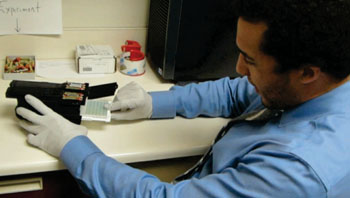Newly Developed Mobile Phone Device Reads ELISA Plates
By LabMedica International staff writers
Posted on 18 Aug 2015
A multidisciplinary team of scientists and clinicians have developed a handheld smartphone-based device that can quickly read standard 96-well microplates with the same level of accuracy as the platforms commonly used in central clinical laboratories. The device, made by 3-D printing, attaches to the smartphone.Posted on 18 Aug 2015
The research team from the University of California Los Angeles (UCLA; Los Angeles, CA, USA), led by Prof. Aydogan Ozcan along with Prof. Dino Di Carlo and Prof. Omai Garner, developed the ELISA reader to enable clinicians to perform these tests at lower cost and with greater flexibility for testing at point-of-care (POC), including in many resource-poor or field settings. “It is quite important to have these kinds of mobile devices, especially for administering medical tests that are usually done in a hospital or clinical laboratory,” said Prof. Ozcan, “This mobile platform can be used for point-of-care testing, screening populations for particular diseases, or tracking vaccination campaigns in most resource-poor settings.”

Image: The new miniature ELISA microplate reader device is created with a 3-D printer and attaches to a smartphone, enabling clinicians to perform lower-cost rapid diagnostic ELISA tests at point-of-care, including in many resource-poor or field settings (Photo courtesy of UCLA).
ELISA testing is most commonly performed with the standard 96-well transparent plastic plates that resemble honeycombs. The new device illuminates the plate with an array of light-emitting diodes (LEDs). The light projected through each well is collected by 96 individual plastic optical fibers. The smartphone transmits the resulting images to UCLA servers through a custom-designed app. The images are then analyzed by a machine-learning algorithm and the results are sent back to the phone for viewing within about 1 minute for the entire 96-well plate.
This mobile platform was compared with the standard FDA-approved well-plate readers at a UCLA clinical microbiology laboratory. The comparison included ELISA tests for mumps, measles, and herpes simplex viruses 1 and 2. Of a total of 571 patient samples, the mobile platform achieved 99.6% accuracy in diagnosing mumps, 98.6% for measles, and 99.4% each for herpes simplex 1 and 2.
“Our team is focused on developing biomedical technologies that work with mobile platforms to assist with on-site testing and health-care in disadvantaged or rural areas,” said Mr. Berg. Prof. Di Carlo added, “We are always looking toward the next innovation, and are looking to adapt the basic design of this ELISA cellphone reader to create smartphone-based quantified readers for other important medical tests.”
The work, by Berg B, et al, was reported online July 9, 2015, in the American Chemical Society journal ACS Nano.
Related Links:
UCLA
California NanoSystems Institute (at UCLA and UCSB)







 assay.jpg)






